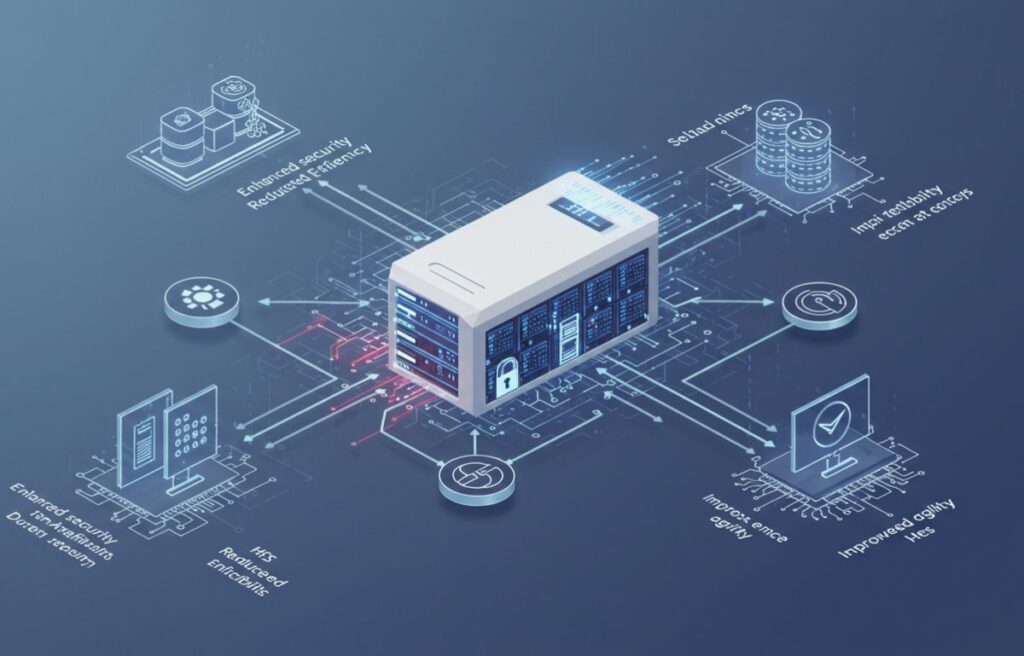In a world where technology evolves at breakneck speed, organizations are constantly seeking solutions that can keep up with their demands. Enter the NS Mainframe—a powerhouse of processing potential designed for modern enterprises. This cutting-edge mainframe system combines unparalleled performance with robust security features to address today’s complex business challenges. Whether it’s handling large data volumes or ensuring seamless integration, the NS Mainframe is emerging as an indispensable asset in various industries. Let’s dive deeper into what makes this technology so vital for businesses navigating the digital landscape.
Evolution of Mainframe Technology
Mainframe technology has come a long way since its inception in the 1950s. Initially, these systems were massive machines that filled entire rooms and catered primarily to governmental and large corporate needs.
As time progressed, mainframes evolved into more compact versions with enhanced processing capabilities. The introduction of integrated circuits marked a significant turning point. This advancement allowed for greater efficiency and reliability.
The 1970s brought about further innovations, including virtualization technologies that allowed multiple applications to run simultaneously on a single machine. This capability transformed how enterprises utilized their computing resources.
Fast forward to today, NS Mainframe reflects this evolution by integrating modern features like cloud connectivity and advanced security protocols. These enhancements enable organizations to leverage powerful computing while maintaining scalability in an ever-changing digital landscape. The journey of mainframe technology demonstrates resilience and adaptability in meeting contemporary business demands.
Key Features of NS Mainframe
NS Mainframe boasts advanced scalability, allowing businesses to effortlessly manage vast workloads. This capability ensures that enterprises can expand their operations without significant downtime or resource strain.
Another critical feature is its robust security framework. With sophisticated encryption and access controls, NS Mainframe protects sensitive data from unauthorized access, making it an excellent choice for industries like finance and healthcare.
The platform also excels in performance optimization. Its processing power enables rapid transaction handling, ensuring that users experience minimal latency even during peak times.
Additionally, the NS Mainframe supports a diverse range of programming languages and applications. This versatility allows organizations to leverage existing software while integrating new technologies seamlessly into their workflow.
With built-in disaster recovery options, companies can maintain business continuity even in unforeseen circumstances. These features combine to create a resilient solution for modern enterprise needs.
Benefits for Modern Enterprises
NS Mainframe offers a myriad of benefits tailored for modern enterprises. Its unparalleled processing power allows organizations to handle vast amounts of data seamlessly. This efficiency translates into faster decision-making and improved operational workflows.
Scalability is another standout feature. As businesses grow, the NS Mainframe can easily accommodate increasing workloads without compromising performance. This adaptability ensures long-term sustainability in an ever-changing market.
Moreover, security remains a top priority with NS Mainframe technology. Advanced encryption and robust access controls protect sensitive information, providing peace of mind in today’s digital landscape.
Cost-effectiveness also plays a crucial role. By optimizing resources and reducing downtime, companies can significantly lower operating expenses while maximizing output.
Its integration capabilities enable smooth interactions with existing systems, making the transition effortless for teams adapting to new technologies.
Use Cases of NS Mainframe in Various Industries
NS Mainframe is proving to be a vital asset across various sectors. In the finance industry, it handles vast transaction volumes securely and efficiently. Banks leverage its capabilities for real-time processing and fraud detection.
Healthcare organizations utilize NS Mainframe for managing patient data and electronic health records. Its reliable infrastructure ensures compliance with strict regulations while providing quick access to information.
Retail businesses benefit from the NS Mainframe’s ability to manage inventory levels, process customer transactions, and analyze buying patterns in real time. This insight helps enhance customer experience significantly.
Telecommunications companies also depend on NS Mainframe technology for billing systems and network management. The system’s reliability minimizes downtime, ensuring uninterrupted service.
Government agencies find value in the robust security features of NS Mainframe as they manage sensitive citizen data. With its scalability, these entities can adapt easily to changing demands without compromising performance or safety.
Implementation and Integration with Existing Systems
Implementing NS Mainframe within an organization requires careful planning. It’s essential to assess existing systems for compatibility and efficiency. A thorough analysis helps identify areas where integration can streamline operations.
Collaboration between IT teams is crucial during this phase. Engaging stakeholders from different departments ensures that everyone is on the same page. This alignment fosters a smoother transition and minimizes disruptions.
Utilizing APIs can facilitate seamless communication between NS Mainframe and legacy systems. This approach promotes data consistency across platforms, enhancing overall functionality.
Training staff on new workflows also plays a vital role in successful implementation. Providing resources and support empowers employees to adapt quickly, ensuring they leverage the full potential of the NS Mainframe system.
Continuous monitoring post-implementation allows organizations to refine processes further, maximizing return on investment while maintaining operational integrity.
Future Outlook for NS Mainframe
The future of NS Mainframe appears bright as technology continues to advance. Organizations are increasingly recognizing the value of leveraging mainframes for complex data processing and analytics.
As enterprises embrace digital transformation, NS Mainframe will play a pivotal role in integrating artificial intelligence and machine learning capabilities. This integration promises enhanced decision-making processes and operational efficiencies.
Additionally, the growing emphasis on cybersecurity will drive innovations within Mainframe systems. With robust security measures embedded into their architecture, businesses can protect sensitive information more effectively than ever before.
Cloud compatibility is another area poised for growth. As hybrid infrastructures become standard practice, NS Mainframe’s ability to seamlessly interact with cloud environments will be crucial for future deployments.
These developments indicate that Mainframe is not just surviving but thriving in an evolving technological landscape. Its adaptability ensures it remains relevant in meeting modern enterprise needs.
Conclusion
The NS Mainframe stands as a testament to the evolution of computing technology, merging decades of reliability with cutting-edge advancements. As modern enterprises navigate an increasingly complex landscape, adopting Mainframe solutions can significantly enhance efficiency and security.
Its key features—robust processing power, seamless scalability, and unparalleled security—make it a compelling choice for businesses aiming to stay competitive. The benefits extend beyond mere performance; organizations gain agility in their operations while ensuring compliance with industry regulations.
Across various sectors like finance, healthcare, and logistics, the practical applications of NS Mainframe illustrate its versatility. These use cases highlight how companies are leveraging this powerful technology to drive innovation and streamline processes.
Implementing Mainframe may seem daunting at first; however, integration with existing systems is often smooth thanks to advanced compatibility options. Organizations that embrace this transition will find themselves better positioned for future challenges.
Looking ahead, the role of the Mainframe is set only to expand as industries continue to evolve digitally. Its enduring capabilities combined with modern adaptability promise a bright outlook for those willing to invest in this pivotal technology shift. Embracing the NS Mainframe today could well be your gateway into tomorrow’s technological landscape.







